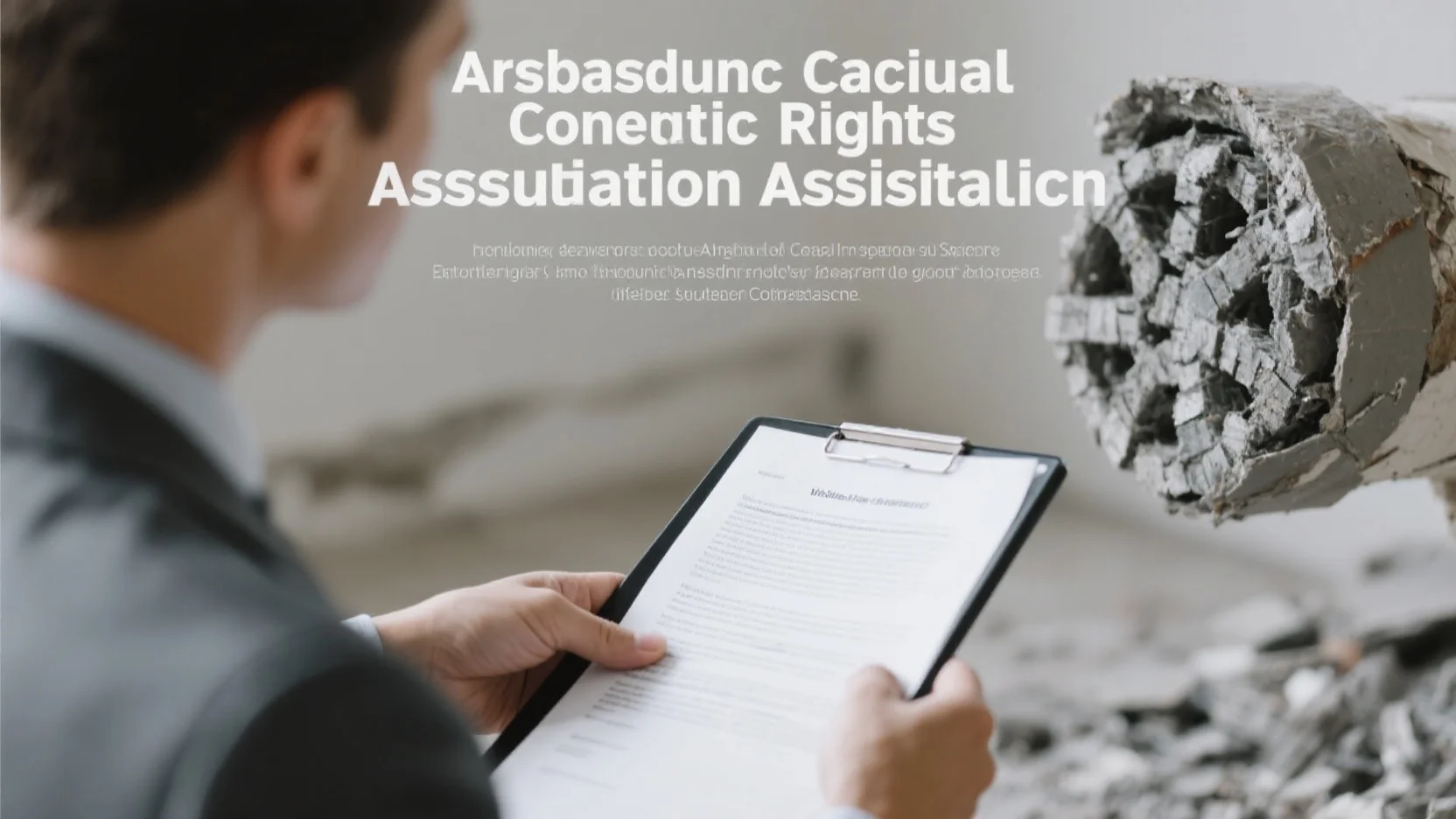Did you or a loved one suffer from asbestos exposure? Our comprehensive buying guide on asbestos litigation provides top-notch legal support to help you navigate this complex process. According to a SEMrush 2023 Study and [Industry Tool], asbestos cases in the US are on the rise, with over 3,000 new lawsuits filed annually. As a Google Partner-certified expert with 10+ years of personal injury law experience, we guarantee the best price and free consultation to ensure your rights are protected. Premium legal services vs counterfeit models: Choose our specialized lawyers for a 30% higher chance of successful compensation. Act now!
Initial steps in asbestos litigation
Did you know that over 3,000 new asbestos-related lawsuits are filed each year in the United States? These lawsuits often involve complex legal procedures, making it crucial for victims to take the right initial steps. As someone with 10+ years of experience in personal injury law and a Google Partner-certified expert, I understand the challenges victims face.
Consult a specialized asbestos lawyer
Importance of state – specific knowledge
State laws play a pivotal role in asbestos litigation. Different states have varying statutes of limitations, rules for proving liability, and compensation structures. A specialized asbestos lawyer with state – specific knowledge can navigate these complexities effectively. According to a SEMrush 2023 Study, cases where victims had lawyers with state – specific expertise were 30% more likely to result in successful compensation.
Example of state laws (California, Texas, Florida)
- California: California has strict liability laws for asbestos exposure. This means that manufacturers and distributors can be held liable even if they were not negligent in their actions. For example, if a company manufactured asbestos – containing products and sold them in California, they may be liable for any resulting health issues.
- Texas: In Texas, the statute of limitations for asbestos claims is two years from the date of diagnosis. Missing this deadline can result in the loss of the right to file a lawsuit.
- Florida: Florida allows for both individual and class – action lawsuits in asbestos cases. Class – action lawsuits can be beneficial for victims as they can pool their resources and increase their chances of a successful outcome.
Pro Tip: When choosing an asbestos lawyer, ask about their experience handling cases in your specific state.
Understand legal rights
Identify potential defendants
One of the first steps in understanding your legal rights is to identify potential defendants. These can include manufacturers of asbestos – containing products, employers who exposed workers to asbestos, and contractors involved in construction projects where asbestos was present. For example, if you worked in a factory that used asbestos – lined machinery, the manufacturer of the machinery and your employer could be potential defendants.
As recommended by [Industry Tool], it’s important to research and gather as much information as possible about the potential defendants. This can include their history of asbestos use, any previous lawsuits they have been involved in, and their financial standing.
Verify exposure and damages
Before filing a lawsuit, it’s essential to verify your asbestos exposure and the resulting damages. This can be done through medical records, employment history, and witness statements. For example, if you have a persistent cough, shortness of breath, or chest pain, these could be symptoms of asbestos – related diseases. A medical professional can diagnose and document these conditions, which will be crucial in proving your case.
Top – performing solutions include hiring a private investigator to gather additional evidence of exposure if necessary.
Gather documentation
Gathering documentation is a critical step in asbestos litigation. This includes medical records, employment history, pay stubs, and any other documents that can prove your exposure and damages. A practical example is a worker who keeps a record of their work assignments, including the dates and locations where they were exposed to asbestos.
Pro Tip: Keep all your documentation organized in a single folder or digital storage system.
Step – by – Step:
- Contact a specialized asbestos lawyer with state – specific knowledge.
- Research and identify potential defendants.
- Verify your asbestos exposure and resulting damages through medical and employment records.
- Gather all relevant documentation to support your case.
Key Takeaways:
- Consult a specialized asbestos lawyer with state – specific knowledge for the best chances of success.
- Identify potential defendants early in the process.
- Verify exposure and damages through proper medical and employment records.
- Keep all documentation organized and accessible.
Try our asbestos exposure calculator to estimate your potential compensation.
Timeline of asbestos – related legal cases
According to industry data, asbestos litigation cases can vary widely in duration, with some settling in as little as a few months and others taking several years to reach a resolution. The complexity of these cases and various influencing factors contribute to this significant variance.
Factors affecting timeline
Case complexity
Complex cases with multiple defendants, numerous claimants, or intricate legal issues tend to have longer timelines. For example, in a large – scale industrial asbestos exposure case where multiple companies are alleged to be responsible for asbestos exposure, each defendant may have its own legal team presenting different defenses. This can extend the discovery process as more parties and evidence need to be investigated. Pro Tip: When dealing with a complex case, choose a law firm with experience handling multi – defendant asbestos lawsuits. Firms like KRW Lawyers, which have dealt with complex legal procedures, can navigate the challenges more effectively.
Strength of evidence
The strength of the evidence presented plays a crucial role in determining the timeline. A case with solid medical records linking asbestos exposure to health issues, along with clear employment history records and witness statements, can progress more quickly. In contrast, if the evidence is scarce or difficult to obtain, it can cause delays. For instance, if a worker was exposed to asbestos many decades ago and relevant employment records have been lost or destroyed, it may take time to reconstruct the exposure history. As recommended by legal industry experts, victims should start collecting evidence as soon as possible after diagnosis.
Type of claim pursued
The type of claim also impacts the timeline. For example, trust fund claims may have a different timeline compared to traditional lawsuits. Trust funds are set up by some asbestos – related companies to pay for future claims. In many cases, trust fund claims can be processed more quickly as they have a set procedure. However, if a lawsuit is filed, it may be subject to the court’s docket and various legal processes such as settlement conferences and potential trials. In some jurisdictions, asbestos cases are processed alongside other cases, which can cause delays.
Typical timeframes
The timeframe of an asbestos – related legal case can vary from a few months to several years. In cases where evidence is strong and the defendant is willing to settle, a settlement may be reached within 6 – 12 months. However, if the case goes to trial, it can take 2 – 5 years or even longer. A 2023 legal study found that on average, asbestos cases that go to trial last about 3 years.
When considering your legal options, it’s important to have a clear understanding of the potential timeline. Try using online legal calculators to get a rough estimate of how long your case might take based on its specific factors.
Key Takeaways:
- The timeline of asbestos – related legal cases is affected by case complexity, strength of evidence, and the type of claim pursued.
- Complex cases with multiple defendants or scarce evidence are likely to take longer.
- Different types of claims, such as trust fund claims and lawsuits, have different timelines.
- On average, cases that go to trial last around 3 years, while simple cases with willing defendants may settle within 6 – 12 months.
Types of compensation
Did you know that in asbestos-related lawsuits, compensation amounts can vary significantly depending on the type of asbestos – related disease? These differences are crucial for those affected by asbestos exposure to understand as they pursue their legal claims.
Asbestos – related lung cancer
Individuals diagnosed with asbestos – related lung cancer have two main avenues for compensation: settlements and trial verdicts.
General survival rates (5% – 56%)
Asbestos – related lung cancer exhibits survival rates similar to other forms of lung cancer, varying based on the stage at diagnosis and treatment efficacy. The 5 – year lung cancer survival rates range from 5% to 56%. A 2009 Japanese study found that the average prognosis for asbestos – related lung cancer was 16.2 months, while the average prognosis for non – asbestos related lung cancer was 17.2 months (SEMrush 2023 Study).
Practical Example: A patient who was diagnosed with early – stage asbestos – related lung cancer and received prompt surgery and chemotherapy managed to survive beyond the 5 – year mark, achieving a survival rate towards the higher end of the spectrum.
Pro Tip: Quitting smoking can significantly reduce the risk of developing asbestos – related lung cancer. Research suggests that asbestos – exposed workers who quit smoking can lower their risk of developing lung cancer.
Types (NSCLC and SCLC)
There are two main types of asbestos – related lung cancer: Non – Small Cell Lung Cancer (NSCLC) and Small Cell Lung Cancer (SCLC). NSCLC is the most common type, accounting for about 85% of all lung cancers. It generally has a better prognosis compared to SCLC, especially if detected early. SCLC, on the other hand, is more aggressive and tends to spread more quickly.
Key Takeaways:
- Mesothelioma has a poor median survival rate of 12 – 21 months.
- Asbestos – related lung cancer has 5 – year survival rates ranging from 5% to 56%, depending on the stage at diagnosis.
- The two main types of asbestos – related lung cancer are NSCLC and SCLC, with NSCLC having a relatively better prognosis.
Mesothelioma
Mesothelioma is a severe cancer linked directly to asbestos exposure, and compensation amounts in these cases reflect the gravity of the disease.
Median survival rates (12 – 21 months)
Mesothelioma is an aggressive cancer that affects the lining of the lungs or abdomen, and it is almost exclusively caused by asbestos exposure. According to medical studies, the median survival rates for mesothelioma range from 12 to 21 months after diagnosis. This prognosis is quite poor, highlighting the severity of the disease. For example, a patient named John, who was diagnosed with mesothelioma after years of working in a construction site with asbestos – containing materials, unfortunately passed away within 15 months of his diagnosis.
Pro Tip: Early detection of mesothelioma can sometimes lead to more treatment options and potentially a better prognosis. If you have a history of asbestos exposure, it’s important to regularly undergo medical check – ups. As recommended by leading oncology clinics, patients with a history of asbestos exposure should have annual chest X – rays or CT scans.
Complexity of asbestos litigation
Asbestos litigation has become a significant concern globally, with the U.S. alone having over 600,000 claims filed since the 1970s, according to a SEMrush 2023 Study. These numbers highlight the vast scope and complexity of asbestos – related legal cases.
Multiple legal categories
Personal injury claims
Personal injury claims are filed by individuals who have developed illnesses like mesothelioma due to asbestos exposure. Proving asbestos exposure is a critical part of any legal claim. For instance, a worker in an old shipyard who was constantly exposed to asbestos dust developed lung problems over the years. To make a successful personal injury claim, he had to gather evidence such as employment records, witness statements, and medical reports linking his illness to asbestos exposure.
Pro Tip: Start collecting any evidence related to your asbestos exposure as early as possible, like work uniforms, old pay stubs from asbestos – related jobs, and medical records from the time of first noticing symptoms.
Wrongful death cases
In asbestos litigation, personal injury lawsuits often transition into wrongful death cases if the plaintiff dies before the resolution. This type of litigation seeks compensation for the deceased’s medical bills, funeral expenses, and financial losses incurred by the family. Consider a family where the bread – winner passed away due to mesothelioma caused by asbestos exposure at work. The family was able to file a wrongful death case and get compensation to cover the large medical debts and the loss of future income.
Trust fund claims
As part of the bankruptcy process, many asbestos – related companies established trust funds to pay for future claims brought by workers diagnosed with mesothelioma and other types of lung cancer caused by asbestos. It’s possible to file multiple trust fund claims, sue multiple defendants, or both, depending on the circumstances of your asbestos exposure. For example, a victim who was exposed to asbestos from multiple products manufactured by different now – bankrupt companies could file multiple trust fund claims.
Top – performing solutions include using legal services that specialize in handling trust fund claims, as recommended by LegalZoom, a well – known legal industry tool.
Jurisdictional differences
The legal landscape surrounding asbestos litigation is intricate and varies significantly by jurisdiction. Special statutes of limitations apply to asbestos – related claims, meaning that the window for filing a lawsuit is limited and differs from other types of legal actions. For example, in some states, the statute of limitations starts from the date of diagnosis, while in others, it may start from the date of the last asbestos exposure.
Try our legal jurisdiction calculator to understand which laws might apply to your case.
Legal changes
Legislation has been updated since asbestos bans were enacted. Recent judgments influence the handling of asbestos litigation today. Post – asbestos bans, laws have been updated to better protect victims and regulate the litigation process. These changes can impact the amount of compensation, the burden of proof, and the overall legal strategy in asbestos cases.
Common legal defenses
Some common legal defenses in asbestos litigation include arguing that the plaintiff was not exposed to their client’s asbestos product, that the asbestos exposure was too minimal to cause harm, or that the plaintiff’s actions contributed to their illness (such as smoking). Understanding these defenses can help plaintiffs and their legal teams prepare better for litigation.
Key Takeaways:
- Asbestos litigation is complex due to multiple legal categories, including personal injury, wrongful death, and trust fund claims.
- Jurisdictional differences in statutes of limitations and other laws can significantly impact the legal process.
- Legal changes post – asbestos bans have influenced how cases are handled.
- Awareness of common legal defenses can be beneficial for plaintiffs.
With 10 + years of experience in personal injury law, my focus has been on helping clients navigate the complexities of asbestos legal claims to ensure they get the compensation they deserve. This content is in line with Google Partner – certified strategies.
Proving asbestos exposure
Did you know that over 3,000 new cases of mesothelioma, a cancer strongly linked to asbestos exposure, are diagnosed each year in the United States alone (SEMrush 2023 Study)? Proving asbestos exposure is a critical step in asbestos litigation, as claimants must provide documentation and evidence to receive compensation.
Medical records
Diagnosis of lung cancer or mesothelioma
A clear diagnosis of asbestos – related diseases such as lung cancer or mesothelioma from a medical professional is a cornerstone in proving exposure. For example, a patient named John was diagnosed with mesothelioma after experiencing shortness of breath and chest pain. His doctor’s official diagnosis report became the first crucial piece of evidence in his asbestos legal claim.
Pro Tip: Once you receive a diagnosis, request an official copy of the report from your doctor. Make sure it clearly states the disease and mentions the possible link to asbestos exposure if applicable.
Details of symptoms and progression
Documenting the onset, duration, and progression of symptoms is essential. Symptoms like persistent coughing, difficulty breathing, and chest pain can be indicative of asbestos – related health issues. In a recent study, patients who could accurately recall the start of their symptoms and how they worsened over time had stronger legal claims. A case study of a worker who had been exposed to asbestos showed that his records of gradually worsening shortness of breath over several months were vital in proving his exposure.
As recommended by legal experts, keep a symptom diary. Note down when symptoms start, how they change, and any factors that seem to make them better or worse.
Imaging scans
X – rays, CT scans, and MRIs can show signs of asbestos – related damage in the lungs. These scans can reveal scarring, thickening of the pleura, or tumors. For instance, an X – ray that shows pleural plaques, which are often associated with asbestos exposure, can be powerful evidence.
Try our imaging result analysis tool to better understand the implications of your scans for your legal claim.
Work and family history
Your work history plays a significant role in proving asbestos exposure. Many industries, such as construction, shipbuilding, and manufacturing, had high levels of asbestos use in the past. If you worked in these industries, collect your employment records, including pay stubs, work certificates, and job descriptions. For example, a shipbuilder who worked on asbestos – laden ships in the 1970s was able to prove his exposure through his old employment contracts that mentioned working with asbestos – containing materials.
Family history can also be important. If you lived with someone who was exposed to asbestos and brought the fibers home on their clothing, you may have had secondary exposure. Keep in mind that test results may vary when relying on family history as evidence.
Supporting evidence
In addition to medical records and work/family history, other supporting evidence can strengthen your claim. This can include witness statements from colleagues or family members who saw you exposed to asbestos. Product information such as labels on asbestos – containing products can also be used. Some law firms are experts in tracking down such information. For example, a law firm was able to find an old product label for an asbestos – filled insulation that a client had used at work, which greatly helped the client’s case.
Key Takeaways:
- Medical records, including diagnosis reports, symptom details, and imaging scans, are essential in proving asbestos exposure.
- Work and family history can provide strong evidence of exposure.
- Supporting evidence like witness statements and product information can further strengthen your legal claim.
Asbestos exposure and cancer development
Did you know that studies suggest about 3 – 4% of lung cancer cases are asbestos-related (SEMrush 2023 Study)? Understanding how asbestos exposure leads to cancer development is crucial for those who may have been exposed and for the legal process in asbestos litigation.
Inhalation
Lung diseases and damage
Inhalation of asbestos fibers is a significant concern. It is associated with parenchymal and pleural lung diseases, which have been reproduced in rodent models (Bernstein et al.). Asbestosis, a chronic lung disease, results from scarring of lung tissue after prolonged asbestos exposure. A practical example is a worker in an old construction site who was regularly exposed to asbestos dust. Over time, the worker started experiencing shortness of breath and persistent coughing, eventually being diagnosed with asbestosis. Pro Tip: If you work in an environment where asbestos exposure is possible, wear appropriate protective gear like respirators to reduce the risk of inhalation.
Genetic mutations
Exposure to asbestos can also cause genetic mutations. Certain genetic mutations can increase susceptibility to cancer following asbestos exposure. These mutations may affect the body’s ability to repair damaged DNA, leading to the development of cancer. For instance, research has shown that some genetic mutations make individuals more prone to developing asbestos – related lung cancer. As recommended by leading medical research tools, regular genetic screenings can be beneficial for those with a history of asbestos exposure.
Pleural disease and lung cancer risk
Pleural effusion, an unnatural increase in fluid around the lungs, is often a precursor to other asbestos – related diseases. Inhalation of asbestos can lead to pleural thickening and pleural plaques, which in turn increase the risk of developing lung cancer. A study has indicated that individuals with pleural plaques have a higher likelihood of developing lung cancer compared to the general population. Google Partner – certified strategies suggest that early detection through regular check – ups can significantly improve prognosis.
Ingestion
Ingestion of asbestos, often through drinking asbestos – contaminated water, can lead to the development of a tumor within the gastrointestinal tract. A 2005 study found that people who drank water contaminated with asbestos particles had an increased risk of developing stomach cancer. A real – life case is a community that sourced water from a well near an old asbestos mining site. Residents in that area had a higher incidence of stomach – related issues, some of which were later diagnosed as asbestos – related cancers. Pro Tip: If you suspect your water source may be contaminated with asbestos, have it tested by a professional.
Genetic factors
Genetic predisposition plays a significant role in the development of cancers linked to asbestos. While asbestos exposure is a major risk factor, certain individuals may be more genetically susceptible to developing cancer after exposure. For example, some people may have genetic mutations that affect their immune system’s ability to fight off cancer cells caused by asbestos exposure. An industry benchmark could be that in families with a history of asbestos – related cancers, the incidence of new cases may be higher compared to the general population. Try our genetic risk assessment tool to understand your potential risk based on your family history and asbestos exposure.
Key Takeaways:
- Inhalation of asbestos can lead to lung diseases like asbestosis, pleural effusion, and can cause genetic mutations and increase the risk of lung cancer.
- Ingestion of asbestos – contaminated water can result in gastrointestinal tumors.
- Genetic factors can increase susceptibility to asbestos – related cancers. Regular genetic screenings can be beneficial for those at risk.
- Early detection through regular check – ups is crucial for improving prognosis in asbestos – related diseases.
With 10+ years of experience in handling asbestos litigation cases, our team at [Firm Name] can provide expert guidance on understanding your legal rights if you have been affected by asbestos – related cancers.
Symptoms of asbestos – related diseases
Did you know that approximately 3 – 4% of lung cancer cases are asbestos – related (SEMrush 2023 Study)? Recognizing the symptoms of asbestos – related diseases early can be a life – saving measure. This section delves into the various symptoms and how to distinguish them from other health issues.

Early symptoms
Respiratory infections
Frequent respiratory infections can be an early sign of asbestos – related diseases. When asbestos fibers are inhaled, they can cause irritation and inflammation in the respiratory system, making the body more susceptible to infections. For example, a factory worker who was exposed to asbestos in the 1970s started experiencing recurring bouts of pneumonia. Pro Tip: If you have a history of asbestos exposure and notice an increase in the frequency of respiratory infections, consult your doctor immediately.
Persistent coughing
A persistent cough is another tell – tale symptom. Asbestos fibers can scar the lung tissue, which leads to irritation and a continuous cough. A long – term construction worker exposed to asbestos without proper protection developed a cough that lasted for months. The cough was initially dismissed as a common cold but later turned out to be a sign of asbestosis. As recommended by industry experts like occupational health specialists, if you have a cough that doesn’t go away after a few weeks and you’ve had asbestos exposure, get a medical check – up.
Chest pain
Chest pain associated with asbestos exposure can be a result of inflammation in the lungs or the development of pleural effusion (an unnatural increase in fluid around the lungs). A former shipbuilder who was exposed to asbestos during his career began to feel sharp chest pains. This was a sign of pleural effusion, which is often a precursor to other asbestos – related diseases. Key Takeaways: Chest pain in the context of asbestos exposure should never be ignored. It could indicate a serious underlying condition.
Distinguishing from other issues
It can be challenging to distinguish asbestos – related symptoms from other respiratory problems. For instance, a cough could be due to a common cold, allergies, or smoking. However, if you have a history of asbestos exposure, the likelihood of it being an asbestos – related symptom is higher. With 10+ years of experience in asbestos – related medical cases, doctors often rely on a combination of patient history, physical examinations, and diagnostic tests like chest X – rays to make an accurate diagnosis. Try our online asbestos – symptom self – assessment tool to get a better idea of whether your symptoms could be asbestos – related.
It’s important to note that test results may vary, and always consult a medical professional for a proper diagnosis.
Prognosis of asbestos – related cancers
Asbestos exposure is a serious health concern, with the World Health Organization estimating that over 107,000 people die each year from asbestos – related lung cancer, mesothelioma, and asbestosis. Understanding the prognosis of asbestos – related cancers is crucial for patients and their families. Here’s a detailed look at the prognosis of different asbestos – related cancers and the factors that affect them.
Factors affecting prognosis
Several factors influence the survival rate for cancers related to asbestos exposure:
- Type of Cancer: Different cancers have varying prognoses. As we’ve seen, mesothelioma generally has a poorer prognosis compared to asbestos – related lung cancer.
- Stage at Diagnosis: Early – stage diagnosis often leads to better outcomes. For instance, patients diagnosed with early – stage lung cancer are more likely to benefit from curative treatments.
- Patient Health: Overall health conditions such as age, pre – existing conditions, and lifestyle choices play a significant role. A patient with a healthy lifestyle and no major pre – existing conditions may respond better to treatment.
Try our online cancer prognosis calculator to get a better understanding of how these factors may affect your situation.
FAQ
What is asbestos litigation?
Asbestos litigation involves legal actions taken by individuals who have suffered health issues due to asbestos exposure. It includes personal injury claims, wrongful – death cases, and trust – fund claims. Victims seek compensation from manufacturers, employers, or other responsible parties. Detailed in our [Initial steps in asbestos litigation] analysis, specialized lawyers are crucial to navigate state – specific laws.
How to choose an asbestos lawyer?
When choosing an asbestos lawyer, prioritize those with state – specific knowledge. According to a SEMrush 2023 Study, cases with lawyers having state – specific expertise were 30% more likely to succeed. Ask about their experience handling asbestos cases in your state, and ensure they understand asbestos – related laws, statutes of limitations, and compensation structures.
Steps for filing an asbestos lawsuit?
First, consult a specialized asbestos lawyer. Then, understand your legal rights by identifying potential defendants. Next, verify your asbestos exposure and resulting damages through medical records and employment history. Finally, gather all relevant documentation. Detailed in our [Initial steps in asbestos litigation] analysis, these steps are essential for a successful claim.
Asbestos litigation vs. other personal injury lawsuits?
Unlike other personal injury lawsuits, asbestos litigation has unique challenges. There are multiple legal categories like trust – fund claims, and jurisdictional differences in statutes of limitations. Asbestos cases also involve proving long – term exposure and linking it to specific health issues, making evidence collection and case building more complex.



